Introduction
Canadians living in rural settings are generally less healthy than their urban counterparts with higher overall mortality rates, shorter life expectancy and a greater risk of death from motor vehicle accidents and suicide1. High incidences of industrial accidents and occupational disease are prevalent in rural-based economies such as farming, fishing, forestry, meatpacking and mining2. However, according to Nagarajanthe most pressing issue for rural Canadians is a lack of access to adequate healthcare services3, and the short supply of health professionals in rural areas may be a contributing factor.
According to recent workforce data, occupational therapists tend to work in more heavily populated locations resulting in a lower per capita distribution of services to rural areas4. Much research has been published regarding the recruitment and retention of rural health professionals but less on the actual nature of rural practice and whether graduates are prepared during their training for the diversity of rural practice. Brockwell, Wielandt and Clark recently described rural practice as 'challenging and far from ideal'(p.71)5.
Major concerns for rural health professionals have been reported as professional isolation6-10; large and diverse caseloads6,11,12; scarce numbers of service providers6; limited availability of resources including equipment6,13; and reduced opportunities for continuing professional development6,10,12,14,15.
A reduced rural occupational therapy workforce results in therapists using more generalist clinical skills, rather than adopting a specialised approach to practice. This can lead to dissatisfaction with rural practice if therapists perceive their work to be less valued by others in the profession16. Lannin and Longland identified the need to acknowledge rural practice as a specialty area and encouraged universities to adequately prepare students 'for the realities of practice' (p.1868.
In the medical, nursing and allied health literature, various strategies have been identified to rectify the shortage of rural health professionals, including the recommendation that students are exposed to rural health practice issues during their training to prepare them for a career in a rural area8,17-25. Few studies have investigated occupational therapy education and its adequacy in preparing students for rural practice5,19,26.
The present study was undertaken to identify the rewards and challenges of current rural practice in the Canadian provinces of Alberta and Saskatchewan, and to ascertain whether rural therapists believed their training had prepared them adequately for the diversity of rural practice.
Methods
The study used a quantitative approach with a self-administered questionnaire. Approval was obtained from the University of Alberta Health Research Ethics Committee, and data was collected in November to December 2007.
Participants
Participants were occupational therapists on the Albertan and Saskatchewan college registries with rural postal codes.
Data collection and analysis
Because existing methods of identifying rural locations in Canada were not useful for this study, questionnaires were mailed out by the respective provincial professional bodies to current registrants working in rural locations. Both registration bodies advised they were easily able to identify rural therapists on their register. The research team did not have access to any identifying data. The questionnaire used in this research was originally designed for a similar Australian study5 and was modified for use in the Canadian context.
The questionnaire, which included both open and closed questions, provided data regarding demographics, current employment conditions, identification of the rewards and challenges of working rurally, and participants' perceptions of the their preparedness for practice. Data from the closed questions were entered into SPSS v14 (SPSS Inc; Chicago, IL, USA; www.spss.com.au) and yielded frequency data and percentages. Responses to open-ended question data were noted, as were frequency rates, before summarizing and theme identification took place.
Results
A total of 59 completed questionnaires (of 225 possible) were returned by participants, providing a response rate of 26.2%. However, some participants did not answer all parts of the questionnaire and there are some instances of missing data.
Demographic characteristics
All study participants were female, with a mean age of about 36 years (Table 1). Approximately 95% indicated spending some time in their lives living in a rural location (range, 1 to 51 years).
Table 1: Participants' demographic characteristics (n = 59)
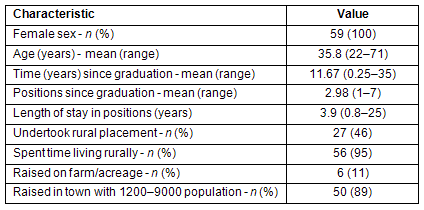
Occupational therapy education
Participants were on average 22 years of age (range, 17-49 years) when they commenced undergraduate training. The mean time since graduation was 11.7 years, and 78% were University of Alberta graduates (there is no occupational therapy program in Saskatchewan). Of the 46% of participants who reported undertaking a rural fieldwork placement as part of their training, 67% (n = 18) perceived this experience to have positively influenced them to work in rural practice.
Positions held since graduation
Since graduation participants had worked in an average of three positions. The average length of stay in each position was approximately 4 years. Greater than two-thirds of these positions were in rural locations. The reasons provided for leaving rural positions included: relocating to another area (31.6%), unhappy with work environment (24%), wanting to change the area of practice (16.2%), contract ended (10.2%), family commitments (8.5%) and change of the number of hours worked (6%). Other individual reasons for leaving positions included being promoted, going to graduate school, travelling overseas and semi-retirement.
Current employment details
Currently participants worked primarily in community healthcare settings, for an average of 30.8 hours per week and mostly with clients who had general physical health issues (Table 2). Greater than half the sample were employed in sole therapy positions. The length of time spent in current positions was on average 5 years. Few participants reported having access to therapist relief.
The 19% of participants (11/59) who advised that they were planning to leave their current positions gave reasons that included: preference for city living (n = 2), imminent maternity leave (n = 2), concentrating on private practice (n = 2), changing practice area (n = 2), spouse transferred away (n = 1), undertaking full-time study (n = 1) and going to work overseas (n = 1). The timing for their change in employment ranged from 1 month to 1 year.
Table 2: Participants' current employment data (n = 59)
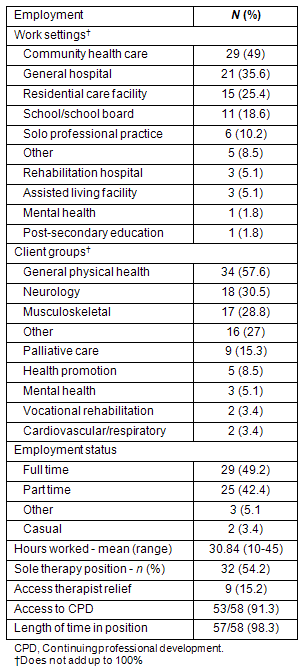
Access to professional support
Participants were asked about access to professional support. They indicated that such support could be formal or informal. Informal support occurred mainly on an 'as needs' basis by email, telephone calls, unscheduled meetings with colleagues or accessing other therapists following regular meetings. Formal support involved meeting with the clinical lead or a supervisor at an arranged time for a specific time with a set agenda.
Participants received mostly informal support (62%), some had a combination of both informal and formal (33%), and 4% reported receiving formal support only. While they found the length of time spent receiving professional support difficult to quantify, participants suggested an average of approximately 30 min to 2 hours per month. Five participants did not have access to professional support because they were either sole therapists (n = 3) and therefore professionally isolated, or they had devised other methods to gain support (n = 2), for example being in contact with a therapist in another region or another allied health professional on their team.
Maintaining professional expertise
All participants reported being able to maintain their professional expertise while working rurally; however, 46% provided no details of activities undertaken. The remainder (n = 32) reported they had attended courses, seminars, workshops, in-services and telehealth sessions (56%), networked and were being mentored (22%), undertook self-directed learning including reading journal articles (12.5%), and used their on-the-job experiences, including covering in other areas of practice (12.5%) to maintain their professional expertise. Interestingly, six participants (10%) advised that they experienced difficulties with this aspect of rural practice. Reasons provided for this were the associated costs (n = 1), courses were urban focussed and not appropriate for generalist practice (n = 3), and feeling overwhelmed by the extent of knowledge required for rural practice and not knowing how to prioritize what to learn first (n = 2). Another participant indicated not having access to professional development because their employer was not able to reimburse costs.
Perceived rewards in rural practice
Participants identified teamwork, independence, diversity and a flexible work schedule as some of mostly rewarding aspects of rural practice (Table 3). Participants also commented positively on other aspects of rural living and these included: 'good for raising children', 'get to know everyone', 'sense of community', 'no commuting in city traffic', 'know and trust neighbours', 'you can see the stars', 'small and friendly', 'slower pace of life'. The availability of many social and recreational opportunities and having friendly workplaces were also viewed favourably.
Perceived challenges in rural practice
The lack of staff, working as a generalist therapist, increased travelling times and reduced access to professional support were reported as the predominant challenges of rural practice (Table 3). While living and working in a rural context was generally prized, some participants identified negative aspects of rural living which included: 'reduced shopping opportunities', 'lack of cultural diversity', long distances from city facilities', difficult if you are young and single', hard to fit in if new', 'spousal employment difficulties' and 'if you commute in from another area then you are not seen as part of the community'. Interestingly, some participants reported a lack of local social and recreational opportunities in their area.
Table 3: Most frequently identified rewards and challenges of rural practice
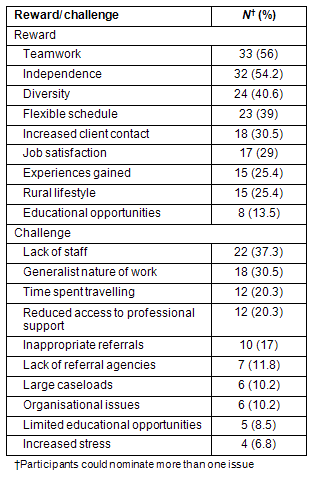
Skills acquired during training that best prepared for rural practice
The various clinical skills attained during their tertiary education (n = 107), followed by courses and educational resources (n = 25) and management and organizational skills (n = 23) were identified by participants as enabling them to cope with the diversity of rural practice (Table 4).
While the majority of clinicians identified skills taught in the occupational therapy curricula, others drew attention to external sources which they had found helpful, including: 'actual practice/hands-on experience in rural practice' (n = 23), 'personal characteristics - adaptability and creativity' (n = 5), 'having some urban experience prior to undertaking a rural career' (n = 2), 'having a rural background' (n = 2) and 'ensuring you had a mentor before embarking on rural practice' (n = 1).
Table 4: Perceptions of the topics/skills learnt during training which best prepared for rural practice
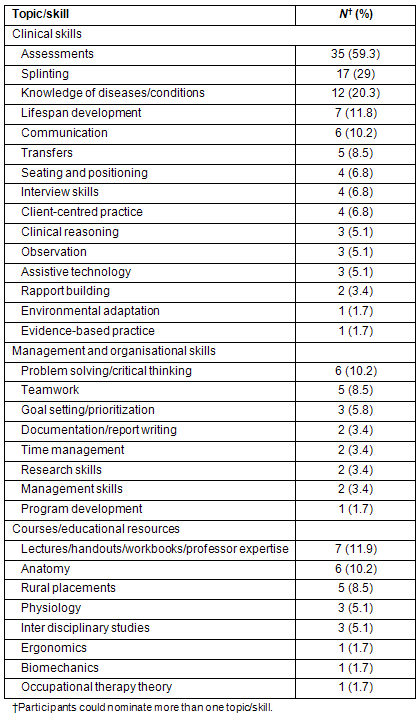
Recommended inclusions for occupational therapy training
In readiness for the diversity of rural practice most study participants suggested the need for additional management and organizational skills to be included in the curriculum (n = 37), followed by extra courses or modules covering a variety of clinical areas (n = 33) and more opportunities to learn about assessments that could be used in various clinical settings (n = 28) (Table 5).
Table 5: Perceptions of the topics/skills not included in training which would have been useful in rural practice
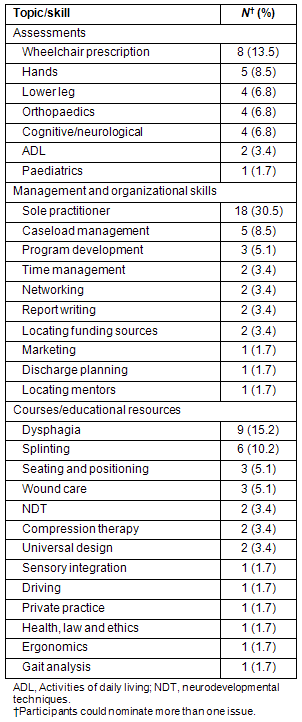
Discussion
A rural background was reported by 95% of the sample, meaning that they had spent some time living in a rural location. This confirms previous evidence that having a rural background is strongly correlated with working in rural practice27-28. Approximately half of the participants indicated having undertaken a rural fieldwork placement during occupational therapy training, with one-third perceiving this experience to have positively influenced them to work in rural practice after graduation. These findings are similar to those reported by others5,28-30. However, rural placements do not always influence students to enter rural practice. Two studies reported that rural placements had actually deterred occupational therapy5 and physiotherapy18 students from seeking employment in a rural setting. Interestingly, over half of the present sample, regardless of whether they had had a rural placement, indicated that they planned to enter rural practice. Lee and Mackenzie13 found that rural clinicians in their study also made a prior commitment to rural practice and, therefore, were not influenced by rural placements.
The rural therapists in the present study had a mean of 12 years experience since graduation, and had worked in an average of almost three positions for approximately 4 years per position. By contrast, Brockwell et al.5 found that Australian rural therapists 5 years after graduation had worked in an average of three positions for a mean time of 17 months per position.
The present study found low numbers of participants (15%) had access to therapist relief and this is similar to what is reported in the available literature12,14,15. This lack of adequate cover can result in a 'massive backlog' (p.174)12 of cases once the therapist returns from leave and can be a contributing factor to feelings of professional isolation should there also be a lack of 'direct support from another occupational therapist' (p.185)8.
Only a small number of participants in this current study indicated that they did not have access to professional support. The majority, however, were mainly engaged in informal support for an average of 30 to 120 min per month. These findings are favourable when compared with those reported in the literature. Steenbergen and Mackenzie advised that none of their participants (new graduates working in rural positions) had access to supervision, including those working with another occupational therapist10. Those who did not receive professional support in this study were primarily sole therapists and, therefore, somewhat professionally isolated, with the others indicating that they garnered support from other health professionals. Mills and Millsteed also found that rural therapists without structured support 'forged links' with other occupational therapists in their region, as well as with other health professionals with whom they worked (p.174)12. When discussing the development of a sole therapy position, Welch, McKenna and Bock advised that establishing contacts and support networks was of the upmost importance31.
The professional development activities undertaken by participants were varied, with only one therapist indicating inability to attend due to a lack of available funding. No literature was located that specified the type of professional development activities of other rural therapists.
All participants in this study were able to maintain their professional expertise while working in a rural setting. However, these results needed be viewed cautiously as almost half of the sample did not provide examples of activities they had undertaken. This finding is still encouraging, however, when compared with Bent's study which found that only 65% of allied health professionals were able to maintain their professional expertise and develop professional knowledge while working in remote areas6. However, in this study six participants advised that they had experienced difficulties in this area because available courses seemed to be mainly urban focused, not appropriate for generalist practice and expensive.
In a bid to identify the characteristics of current rural practice study in Canada, participants were asked about the rewards and challenges of their current position. It is interesting to note that some aspects of rural practice considered by some participants to be challenging were seen by others as rewarding.
Participants were more likely to identify the rewards of rural practice than its challenges. Highly valued aspects of rural practice included: teamwork, autonomy, diversity, flexible work schedule, increased client contact, job satisfaction, clinical experiences gained and the rural lifestyle. There is little literature available regarding the perceived benefits of rural occupational and physiotherapy practice; however, some of the aspects identified in this study are similar to the findings of others, including varied caseload6,13,32; autonomy and flexibility6,11,32 and the rural lifestyle11,13,32.
Staff shortages, the generalist nature of rural occupational therapy practice, time spent travelling and coping with inappropriate referrals were the most frequently identified challenges. Furthermore, although the majority of participants indicated they had professional support about one-fifth said that they needed more.
The current shortages of medical and allied health personnel in Canada, generally and specifically, in rural areas are of concern. With the impact of an ageing population the demands for rehabilitation will rise over the next decade32. In a recent review of the recruitment and retention literature, 34 strategies for improving the quality of life and work environment, financial incentives and marketing, workload and skill mix, professional development and education and training issues experienced by rural health professionals33.
Rural therapists in other studies have found that the generalist occupational therapy role has led them to see themselves as a 'jack-of-all-trades'34,35. However, Bent suggested that rural therapists are actually 'expert generalists' by virtue of the services they offer to a wide client group with varied conditions that require a diverse range of therapeutic skills (p.208)6.
The literature concerning the amount of time rural therapists spend travelling is scarce. Bent reported that the therapists in her study travelled vast distances in central Australia; while they admitted it was tiring they regarded it as an opportunity to see the outback scenery6. A small number of participants in the present study also found travelling to be rewarding; however, more identified it as a challenge. This may be due to the hazardous rural driving conditions in the prairie provinces of Canada during winter.
The lack of access to professional support was reported as a challenge, as was reported in several other studies6,12,19,32. Mills and Millsteed interviewed former rural therapists who reported that minimal professional support contributed to them leaving rural positions12.
Inappropriate referrals were also considered part of the challenge of rural practice in the present study. Devine reported that rural therapists were frustrated with the time involved in explaining to clients and other health professionals about their role19.
The clinical skills gained during their occupational therapy education were most frequently perceived to have best prepared participants for rural practice. Comparable results are reported by Devine, who found that rural and remote health care and health promotion subjects were considered equally important in preparing for rural practice19. Conversely, Brockwell et al. reported that fieldwork placements were thought to have better equipped both urban and rural therapists for occupational therapy practice5.
The need to be taught management and organisational skills was the most common suggestion from participants regarding curricula changes, because this would assist them to cope more effectively with the usually large and varied caseload of rural practice. Other studies had similar findings and their suggestions for improving curriculum content include administrative and management skills5,8,19, organisational skills5 and caseload prioritisation skills8.
Limitations
The study limitations include the small sample size. The response rate of 26.2% may be a consequence of the questionnaires being mailed out close to the end of the year. Also a few therapists commented negatively about the number of the open-ended questions and the time it had taken them to complete the survey. Interestingly, a large number of questionnaires were returned unanswered with recipients indicating that they did not consider themselves rural therapists due to the resources they could easily access. This highlights the need for the profession to expand its thinking about rural practice, because geographic location can no longer be regarded as a reliable predictor of professional resource availability. Indeed, some western Canadian regional health boards, which encompass rural communities, have invested in providing their employees with extensive access to a wide range of online and telehealth resources. Subsequently some participants who worked in rural communities no longer considered themselves to be disadvantaged rural practitioners. While these findings cannot be generalized they have produced a snapshot in time of current rural practice issues in western Canada.
Conclusion
The present study identified the characteristics of rural practice according to occupational therapists who work predominantly as sole therapists in community healthcare settings in rural western Canada. While current rural practice appeared to be mostly satisfying there were some contradictory perceptions of such practice. Maintenance of professional expertise was mainly achieved with only small numbers indicating difficulties in accessing professional support. While these results are more favourable than those reported elsewhere, there is still a need to investigate the specific professional support needs of rural therapists.
On the whole participants perceived that they were adequately prepared for rural practice during their training; however, they made recommendations for additional management and organisational courses in the curricula to assist future therapists to effectively manage the large and diverse caseloads of rural practice.
Finally, this study has suggested that the nature of rural practice is changing, due to an increase in access to online and telehealth resources in some regional areas. Further research will expand the profession's understanding of rural practice, as well as assist in the training of occupational therapists for the rural workforce.
Acknowledgements
The first author was supported to by a University of Alberta, Faculty of Rehabilitation Medicine Small Faculties Grant (2007-2008). The rural therapists from Alberta and Saskatchewan are sincerely thanked for their time and participation in this study.
References
1. Canadian Institute for Health Information. How healthy are rural Canadians?: An assessment of the initiative 'Canada's Rural Communities: Understanding rural health and its determinants'. Ottawa: CIHI, 2006.
2. Laurent S. Rural Canada: Access to health care. (Online) 2002. Available: http://dsp-psd.communication.gc.ca/Collection-R/LoPBdP/BP/prb0245-e.htm (Accessed 21 July 2009).
3. Nagarajan KV. Rural and remote community health care in Canada: Beyond the Kirby Panel Report, the Romanow Report and the Federal Budget of 2003. Canadian Journal of Rural Medicine 2004; 9(4): 245-251. Available: http://www.cma.ca/index/cfm/ci_id/41975/la_id/1.htm (Accessed 21 July 2009).
4. von Zweck C. The occupational therapy workforce in Canada. Occupational Therapy Now 2006; 8: 17-20.
5. Brockwell D, Wielandt T, Clark M. Four years after graduation: Occupational therapists' work destinations and perceptions of preparedness for practice. Australian Journal of Rural Health 2009; 17: 71-76.
6. Bent A. Allied health in central Australia: Challenges and rewards in remote area practice. Australian Journal of Physiotherapy 1999; 45: 203-212.
7. Elliott-Schmidt R, Strong J. Rural occupational therapy practice: A survey of rural practice and clinical supervision in rural Queensland and Northern New South Wales. Australian Journal of Rural Health 1995; 3: 122-131.
8. Lannin N, Longland S. Viewpoint Article. Critical shortage of occupational therapists in rural Australia: Changing our long held beliefs provides a solution. Australian Occupational Therapy Journal 2003; 50: 184-187.
9. Millsteed J. Issues affecting Australia's rural occupational therapy workforce. Australian Journal of Rural Health 1997; 6: 73-76.
10. Steenbergen K, Mackenzie L. Professional support in rural New South Wales: Perceptions of new graduate occupational therapists. Australian Journal of Rural Health 2004; 12: 160-165.
11. Hegney D, McCarthy A, Rogers-Clark C, Gorman D. Why nurses are attracted to rural and remote practice? Australian Journal of Rural Health 2002; 10: 178-186.
12. Mills A, Millsteed J. Retention: An unresolved workforce issue affecting rural occupational therapy services. Australian Occupational Therapy Journal 2002; 49: 170-181.
13. Lee S, Mackenzie L. Starting out in rural New South Wales: The experiences of new graduate occupational therapists. Australian Journal of Rural Health 2003; 11: 36-43.
14. Curran VR, Fleet L, Kirby F. Factors influencing rural health care professionals access to continuing professional education. Australian Journal of Rural Health 2006; 14: 51-55.
15. Daly J, Adamson L, Chang E, Bell P. The research and educational priorities of rural occupational therapists. Australian Health Review 1997; 20(1): 129-138.
16. Fitzgerald K, Hornsby D, Hudson L. A study of allied health professionals in rural and remote Australia. A report to the Rural Health Support Education & Training (RHSET) programme. Canberra, ACT: Commonwealth of Australia, 2000. Available: www.sarrah.org.au/ (Accessed 17 August 2010).
17. Bushy A, Leipert B. Factors that influence students in choosing rural nursing practice: A pilot study. Rural and Remote Health 5: 387. (Online) 2005. Available: http://www.rrh.org.au (Accessed 21 May 2009).
18. Butler C, Sheppard L. The impact of undergraduate rural education on recently graduated physiotherapists. Australian Journal of Physiotherapy 1991; 45: 23-31.
19. Devine S. Perceptions of occupational therapists practicing in rural Australia: A graduate perspective. Australian Occupational Therapy Journal 2006; 53: 205-210.
20. Dunbabin J, Levitt L. Rural origin and rural medical exposure: Their impact on the rural and remote medical workforce in Australia. Rural and Remote Health 3: 212. (Online) 2003. Available: http://www.rrh.org.au (Accessed 21 May 2009).
21. Kohler E, Mayberry W. A comparison of practice issues among occupational therapists in the rural northwest and the Rocky Mountain regions. American Journal of Occupational Therapy 1993; 47(8): 731-737.
22. Laurence C, Newbury J, Wilkinson D. Increasing rural activity and curriculum content in the Adelaide University medical school. Australian Journal of Rural Health 2002; 10: 220-228.
23. Lawrance R. Can training reduce the rural workforce shortage? Australian Family Physician 2004; 33(3): 173-174.
24. Veitch C, Underhill A, Hays RB: The career aspirations and location intentions of James Cook University's first cohort of medical students: A longitudinal study at course entry and graduation. Rural and Remote Health 6: 537. (Online) 2006. Available: http://www.rrh.org.au (Accessed 21 May 2009).
25. Laurence COM, Wilkinson D. Towards more rural nursing and allied health services: Current and potential rural activity in the Division of Health Sciences of the University of South Australia. Rural and Remote Health 2: 105. (Online) 2002. Available: http://www.rrh.org.au (Accessed 21 May 2009).
26. Adamson BJ, Hunt AE, Harris LM, Hummel J. Occupational therapists' perceptions of their undergraduate education for the workplace. British Journal of Occupational Therapy 1998; 61(4): 173-179.
27. Laven G, Wilkinson D. Rural doctors and rural backgrounds: How strong is the evidence? A systematic review. Australian Journal of Rural Health 2003; 11: 277-284.
28. Playford D, Larson A, Wheatland B. Going country; rural students placement factors associated with future rural employment in nursing and allied health. Australian Journal of Rural Health 2006; 14: 14-19.
29. Bourke L, Sheridan C, Russell U, Jones G, DeWitt D, Liaw ST. Developing a conceptual understanding of rural health practice. Australian Journal of Health 2004; 12: 181-186.
30. Eley D, Baker P: Does recruitment lead to retention? Rural clinical school training experiences and subsequent intern choices. Rural and Remote Health 6: 511. (Online) 2006. Available: http://www.rrh.org.au (Accessed 21 May 2009)
31. Welch M, McKenna K, Bock L. Developing a sole occupational therapy position in a rural area. Australian Occupational Therapy Journal 1992; 39(2): 27-29.
32. Stagnitti K, Schoo A, Reid C, Dunbar J. Retention of allied health professionals in the south west of Victoria. Australian Journal of Rural Health 2005; 13: 364-365.
33. Tran D, Hall LM, Davis A, Landry MD, Burnett D, Berg K, Jaglal S. Identification of recruitment and retention strategies for rehabilitation professionals in Ontario, Canada: Results from expert panels. BMC Health Services Research 2008; 8: 249. Available: http://www.biomedcentral.com/1472-6963/8/249 (Accessed 21 July 2009).
34. Peterson C, Ramm K, Ruzicka, H. Occupational therapists in rural healthcare: A jack- of-all-trades'. Occupational Therapy in Health Care 2003; 17(1): 55-62.
35. Wills K, Case-Smith J. Perceptions and experiences of occupational therapists in rural schools. American Journal of Occupational Therapy 1996; 50(5): 370-379.
Abstract
Introduction: Currently Canadians living in rural communities tend to have a poorer health status than those living in urban settings. This is contributed to by the shortage of health professionals choosing work in rural and remote areas. Over the past decade there has been much research into the recruitment and retention of rural health professionals. However little has been done to identify the actual nature of rural practice and whether graduates have been adequately prepared for the diversity of rural work. The present study sought to identify the rewards and challenges of rural occupational therapy practice in western Canada. Participants' were also asked about their preparedness for rural practice after graduation, and specifically about the usefulness of course work and practical skills taught as undergraduates.
Methods: Participants were occupational therapists working in rural communities in the Canadian provinces of Alberta and Saskatchewan. The quantitative approach employed a self-administered survey with closed- and open-ended questions. Data were entered into SPSS v14 (www.spss.com.au) for frequency data and percentages.
Results: The participants (n = 59) worked mainly in full-time community healthcare positions with clients who had physical health issues. More than half worked in sole therapy positions. The average length of time in their current position was 5 years. Most participants reported that they were receiving informal professional support, with some receiving a formal support as well. Participants more frequently identified the rewards of rural practice (n = 214) than its challenges (n = 112). Perceived rewards included team work, autonomy, diversity and flexible work schedule, increased client contact, job satisfaction, experiences gained and the rural lifestyle. The most frequently mentioned challenges included staff shortages, the generalist nature of rural occupational therapy practice, excess time spent travelling, coping with inappropriate referrals and the need for more professional support. Regarding participants' perceptions about the course work and practical skills taught during their training that best prepared them for actual practice, some highlighted additional valuable resources such as actual hands-on experience during rural fieldwork placement, personal characteristics, working in an urban setting prior to embarking on a rural career, coming from a rural background and locating a mentor prior to working rurally. Some recommended increasing management and organisational skills content in the curriculum because these were considered essential skills for effective rural practice. The return of unanswered questionnaires by participants who did not consider themselves to be rural therapists because of access to online and telehealth resources suggests further research is warranted into the changing nature of rural practice.
Conclusion: Characteristics of current rural occupational therapy practice in western Canada were identified. Overall, rural occupational therapy practice appeared to be rewarding, and few had difficulty in accessing professional support. While on the whole the participants believed their training prepared them adequately for rural practice, the acquisition of increased management and organisational skills during training was seen as necessary to effectively manage their typically large and diverse caseloads. Participants' access to online and telehealth resources appears to have markedly changed the nature of rural practice and further research is recommended to determine the impact of such technologies.
Keywords: occupational therapy education, preparation for practice, recruitment, retention, rural workforce.
You might also be interested in:
2018 - Health Disparities in Rural Communities: Challenges and Opportunities
2008 - The geographic relationships between medical students' birth location and high school location

